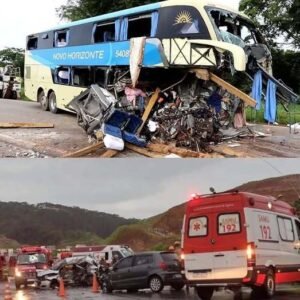An Uneasy Global Climate and a Stark Warning
In an age where headlines are dominated by power struggles between superpowers, surging nationalism, and technological warfare, one underlying threat remains eerily relevant: the possibility of a full-scale global conflict. While much of modern warfare has shifted toward cyber attacks, trade sanctions, and proxy battles, the specter of nuclear warfare still looms large over global security discussions. And as diplomatic tensions rise once more, a renewed question haunts military analysts and civilians alike: If World War III were to begin, what American cities would be the first targets?
It’s a question that’s as chilling as it is strategic. While we may associate large metropolitan hubs with political significance and military power, the calculus behind nuclear targeting isn’t always that straightforward. What does a nation strike when it wishes to disable, demoralize, or strategically cripple its opponent? That’s precisely what nuclear historian and weapons policy expert Professor Alex Wellerstein sought to explore. And some of his answers may surprise you.
Why This Conversation Is More Relevant Than Ever
Tensions across multiple geopolitical fronts have escalated in recent months. President Donald Trump’s recent decision to authorize strikes on Iranian nuclear facilities drew sharp international reactions—not only from Iran itself, but also from Russia, which has maintained a complex web of alliances in the Middle East.
Russian President Vladimir Putin, currently entrenched in an ongoing war with Ukraine, responded with heightened rhetoric. Meanwhile, diplomatic bridges with China have further strained over trade disputes, military posturing in the South China Sea, and continued tech embargoes.
Amid this backdrop, Professor Wellerstein from the Stevens Institute of Technology has outlined 15 American cities that, based on military, strategic, and symbolic importance, could be among the first to be hit in the event of a nuclear attack. His analysis explores not only military installations but also the psychology of war—what targets could yield maximum disruption?
The Two Paths of Nuclear Strategy
According to Wellerstein, the nature of the attacking nation plays a pivotal role in target selection. “If the adversary is Russia and their goal is to disable U.S. retaliation,” he explains, “command centers and ICBM sites will be hit first. If the attacker is a rogue actor, symbolic or densely populated areas might be targeted instead.”
Let’s break down the cities that make his list—some predictable, some shockingly under the radar.
1. Great Falls, Montana
Population: 60,422
Why It’s on the List: Despite being small, Great Falls is near Malmstrom Air Force Base, one of the U.S.’s key intercontinental ballistic missile (ICBM) hubs. The facility manages hundreds of missile silos, making it a high-value military target.
Great Falls exemplifies how rural America is still deeply embedded in the nation’s strategic defense framework. A strike here would aim to neutralize America’s second-strike capability.
2. Cheyenne, Wyoming
Population: 65,168
Strategic Value: Home to Francis E. Warren Air Force Base, a crucial command post for U.S. nuclear operations. Like Malmstrom, it’s part of the Air Force Global Strike Command.
Though relatively obscure in the public eye, Cheyenne is vital in national defense—a prime candidate for a first strike seeking to decapitate nuclear command capabilities.
3. Ogden and Clearfield, Utah
Combined Population: 121,737
Target Reason: These twin cities sit adjacent to Hill Air Force Base, a key logistics and nuclear support hub.
Though nestled beside the tranquil Great Salt Lake, this region plays an outsized role in maintaining America’s airborne nuclear readiness. In WW3, that makes it a bullseye.
4. Shreveport, Louisiana
Population: 177,959
Why It’s a Target: Proximity to Barksdale Air Force Base, home of B-52 bombers—some of which are capable of delivering nuclear payloads.
A strike here would attempt to ground America’s long-range bombers before they ever left the tarmac.
5. Honolulu, Hawaii
Population: 341,778
Historical Context and Strategic Relevance: Given its role in World War II and as a key Pacific military staging ground, Honolulu remains highly significant.
With both air and naval installations and its mid-Pacific location, it serves as a crucial pivot point between Asia and the U.S. mainland.
6. Omaha, Nebraska
Population: 483,335
Military Importance: Offutt Air Force Base, the command center for U.S. Strategic Command, lies nearby.
As a central node in America’s nuclear command-and-control system, Omaha would likely be among the earliest strategic targets.
7. Colorado Springs, Colorado
Population: 488,664
Home of NORAD: The North American Aerospace Defense Command operates here from a mountain bunker.
This city plays a key role in early-warning systems and airspace defense. Taking it out would cripple America’s ability to detect incoming strikes.
8. Albuquerque, New Mexico
Population: 560,274
Nuclear Arsenal Location: Kirtland Air Force Base holds one of the country’s largest nuclear weapons stockpiles.
The city is also deeply linked to the broader U.S. nuclear research complex.
9. Washington, D.C.
Population: 678,972
Obvious but Critical: As the seat of the U.S. government and military leadership, it’s a symbolic and tactical priority.
An attack here would be a decapitation strike—aiming to plunge the country into confusion.
10. Seattle, Washington
Population: 737,015
Why It Matters: Near Naval Base Kitsap, home to nuclear-armed submarines and warhead storage.
Its geography—surrounded by water and mountains—would make evacuation and disaster response especially difficult.
11. San Francisco, California
Population: 873,965
Symbolic and Economic Importance: While not a major military base, its role as a tech and economic powerhouse makes it a high-impact symbolic target.
The San Francisco Bay Area also includes multiple tech industry firms with defense contracts, adding to its value.
12. Houston, Texas
Population: 2.3 million
Energy and Infrastructure Hub: Houston’s extensive oil infrastructure and ports make it a strategic economic target.
Its vulnerability is compounded by its sprawling urban layout and population density.
13. Chicago, Illinois
Population: 2.6 million (City); 9.6 million (Metro)
Third Largest City: With major financial centers, infrastructure, and symbolic influence, Chicago represents both a strategic and morale-target.
It would also disrupt transportation networks across the Midwest.
14. Los Angeles, California
Population: 3.8 million
Hollywood and Beyond: A major port city, aerospace hub, and cultural icon.
Beyond the loss of life, a strike here would deliver a massive psychological blow to the nation.
15. New York City, New York
Population: 8.8 million
America’s Crown Jewel: The economic, financial, and cultural center of the U.S. It’s no stretch to say that a nuclear strike on NYC would alter the trajectory of human history.
A Disturbing but Necessary Discussion
While the idea of nuclear war may seem like a Cold War relic, modern geopolitics continues to test the boundaries of deterrence theory. Professor Wellerstein’s list offers more than just speculative fear—it offers a window into how military strategists assess vulnerability and prioritize targets in worst-case scenarios.
The list is not meant to inspire panic but to provoke serious discussion about emergency preparedness, diplomatic engagement, and nuclear de-escalation strategies.
What Can Be Done?
Policy experts, think tanks, and defense strategists argue that the best defense is prevention. Renewed arms control agreements, robust diplomatic efforts, and updated civil defense systems can all contribute to reducing the risks.
Everyday Americans can also advocate for transparency, preparedness, and education about nuclear policy. Grassroots movements during the Cold War era helped influence public policy—perhaps it’s time for such movements to re-emerge.
Final Thoughts
The possibility of nuclear conflict is a grim topic, but one that remains a part of our strategic reality. Whether these 15 cities ever face such a fate depends largely on the choices made by current and future leaders. One thing remains clear: discussions like these aren’t alarmist—they’re realistic.
Because if we understand the risks, we’re better prepared to prevent them.





